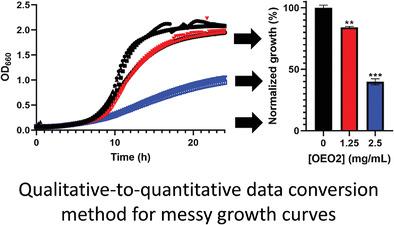Our official English website, www.x-mol.net, welcomes your
feedback! (Note: you will need to create a separate account there.)
Overcoming stochastic variations in culture variables to quantify and compare growth curve data
BioEssays ( IF 3.2 ) Pub Date : 2021-06-14 , DOI: 10.1002/bies.202100108 Christopher W Sausen 1, 2 , Matthew L Bochman 1
BioEssays ( IF 3.2 ) Pub Date : 2021-06-14 , DOI: 10.1002/bies.202100108 Christopher W Sausen 1, 2 , Matthew L Bochman 1
Affiliation

|
The comparison of growth, whether it is between different strains or under different growth conditions, is a classic microbiological technique that can provide genetic, epigenetic, cell biological, and chemical biological information depending on how the assay is used. When employing solid growth media, this technique is limited by being largely qualitative and low throughput. Collecting data in the form of growth curves, especially automated data collection in multi-well plates, circumvents these issues. However, the growth curves themselves are subject to stochastic variation in several variables, most notably the length of the lag phase, the doubling rate, and the maximum expansion of the culture. Thus, growth curves are indicative of trends but cannot always be conveniently averaged and statistically compared. Here, we summarize a simple method to compile growth curve data into a quantitative format that is amenable to statistical comparisons and easy to graph and display.
中文翻译:

克服培养变量的随机变化以量化和比较生长曲线数据
生长比较,无论是在不同菌株之间还是在不同生长条件下,都是一种经典的微生物技术,可以根据分析的使用方式提供遗传、表观遗传、细胞生物学和化学生物学信息。当采用固体生长培养基时,这种技术受到很大程度的定性和低通量的限制。以生长曲线的形式收集数据,尤其是多孔板中的自动数据收集,可以避免这些问题。然而,生长曲线本身受几个变量的随机变化影响,最显着的是滞后期的长度、倍增率和培养的最大扩展。因此,增长曲线表示趋势,但不能总是方便地进行平均和统计比较。这里,
更新日期:2021-07-23
中文翻译:

克服培养变量的随机变化以量化和比较生长曲线数据
生长比较,无论是在不同菌株之间还是在不同生长条件下,都是一种经典的微生物技术,可以根据分析的使用方式提供遗传、表观遗传、细胞生物学和化学生物学信息。当采用固体生长培养基时,这种技术受到很大程度的定性和低通量的限制。以生长曲线的形式收集数据,尤其是多孔板中的自动数据收集,可以避免这些问题。然而,生长曲线本身受几个变量的随机变化影响,最显着的是滞后期的长度、倍增率和培养的最大扩展。因此,增长曲线表示趋势,但不能总是方便地进行平均和统计比较。这里,











































 京公网安备 11010802027423号
京公网安备 11010802027423号